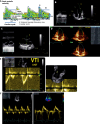Point of care ultrasound evaluation of cardio-cerebral coupling
- PMID: 40880561
- PMCID: PMC12304930
- DOI: 10.5492/wjccm.v14.i3.101462
Point of care ultrasound evaluation of cardio-cerebral coupling
Abstract
Cardio-cerebral coupling (CCC) refers to the dynamic interplay between cardiac function and cerebral blood flow, essential for maintaining hemodynamic stability. Disruptions in CCC are particularly relevant in critical care, where they can exacerbate primary and secondary brain injuries. Ultrasound-based techniques, including transcranial Doppler, transcranial color-coded Doppler, and echocardiography, provide non-invasive methods to assess this relationship at the bedside. This scoping review explores the pathophysiology of CCC, ultrasound methodologies for its evaluation, and its clinical relevance. Key mechanisms such as cerebral autoregulation and neurovascular coupling are discussed, along with ultrasound-derived parameters like pulsatility index, resistance index, and cerebral perfusion pressure. While ultrasound is a valuable tool, its limitations include operator dependency and equipment variability. Emerging evidence suggests that ultrasound-guided protocols, including ultrasound-guided cardio-cerebral resuscitation protocol and ultrasound-guided brain injury treatment protocol, may improve resuscitation strategies and neurocritical care monitoring. Despite its potential, further research is necessary to standardize assessment methods and integrate ultrasound-based CCC evaluation into routine clinical practice. Ongoing multicenter studies are expected to provide robust evidence supporting its clinical utility in managing brain-injured patients.
Keywords: Brain circulation assessment; Cardio-cerebral coupling; Cardiovascular physiology; Cerebral autorregulation; Cerebral blood flow physiology; Echocardiography; Transcranial Doppler.
©The Author(s) 2025. Published by Baishideng Publishing Group Inc. All rights reserved.
Conflict of interest statement
Conflict-of-interest statement: All the authors report no relevant conflicts of interest for this article.
Figures







References
-
- Castle-Kirszbaum M, Parkin WG, Goldschlager T, Lewis PM. Cardiac Output and Cerebral Blood Flow: A Systematic Review of Cardio-Cerebral Coupling. J Neurosurg Anesthesiol. 2022;34:352–363. - PubMed
-
- Langfitt TW. Increased intracranial pressure. Clin Neurosurg. 1969;16:436–471. - PubMed
-
- Rosner MJ, Newsome HH, Becker DP. Mechanical brain injury: the sympathoadrenal response. J Neurosurg. 1984;61:76–86. - PubMed
-
- Rosner MJ, Becker DP. Origin and evolution of plateau waves. Experimental observations and a theoretical model. J Neurosurg. 1984;60:312–324. - PubMed
-
- Rosner MJ. Introduction to cerebral perfusion pressure management. Neurosurg Clin N Am. 1995;6:761–773. - PubMed
Publication types
LinkOut - more resources
Full Text Sources

